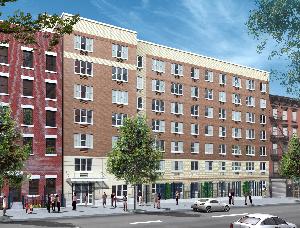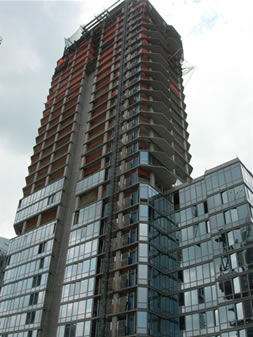[Real Deal] 7/06
In 2003, Richard Bassuk, president of Singer and Bassuk Organization, penciled out the costs for a residential project on Fifth Avenue and 26th Street. Construction costs were between $175 and $180 a foot. Three years later, when he arranged the financing for a project across the street, construction costs had doubled to at least $400 a foot.Market watchers say construction costs have gone up 30 percent in the past year alone -- and if the prices continue to rise, it may bring the condo industry to a stall.
Certainly, lenders and developers are losing enthusiasm to take on new projects. More desirable now are conversions, which require less materials and labor than new construction. Some developers are also changing the materials they use -- goodbye, steel, and hello, reinforced concrete.
***
Cost of copper spiked"With Sundari, there have been surprises, cost increases that not only surprised me, but dozens of others," said Heiberger. "The increase in costs of steel, concrete and sheetrock -- those three line-items have gone up, along with labor."Spikes, from concrete to copperEconomic development in China, which is increasing demand for raw materials, is partly to blame.
According to a construction cost index by the Engineering News-Record, which tracks the construction industry, the price of cement increased by 8 percent from this time last year, and the price of steel increased by 8.4 percent during the same period.
Concrete is 15 to 18 percent more expensive today than a year ago, says Chris Zegler, vice president of New York construction services at Turner Construction.
Also seeing a substantial increase is the cost of copper, used for both plumbing and electrical construction; Turner reported national costs of copper wire increased by over 100 percent since the end of March.Contributing to the national demand for construction materials is the reconstruction in areas hit by Hurricane Katrina in 2005. The demand for oil is further aggravating the issue, pushing prices up in fuel costs and oil-based construction materials.
With land prices running $300 and $400 a square foot in many cases and construction costs as high, it's easy to see that developers don't have an extraordinary amount of wiggle room to charge less than $1,000 a square foot for condos and still turn a profit, according to observers.Labor painsLabor costs are another consideration.
***
Labor painsCondo conversions like Heiberger's Greenwich Club Residences require fewer materials, but labor remains a high line-item cost across the board."Three years ago, the New York market was still recovering from September 11, and subcontractors didn't have a full book of transactions," said Bassuk. Now demand for subcontractors is so high it has many development budgets in the red. "Subcontractors are extremely busy and while you can still get subcontractors to perform in time, it has been over the budget," Heiberger said. "The demand is so great that, effectively, there is a labor shortage."
Unfortunately for developers, it will take fewer condo development starts before the demand for subcontractor services levels off, said Bassuk. "When [subcontractors] don't have an unlimited amount of work, they'll start to adjust their pricing," he added.
Little leewayIn the meantime, developers are the ones adjusting their sale prices to include the rise in costs -- with hopes that the demand will still be as strong when these condos hit the market.According to Heiberger, some investments likely to fail were secured last summer with little financial leeway for construction costs. "Some developers can't just raise the price to make up for the short-term shortages," Heiberger said.There have been a few deals so tightly budgeted that the rising construction costs will strangle financing, says Heiberger. "
But three out of a hundred developments is not an epidemic amount of bloodshed spread."At investment banking firm Sonnenblick Goldman managing director and principal Rick Swartz said he has seen projects get put on hold because of the increases in construction costs combined with the slowdown perceived in the rising of prices. (Swartz declined to name particular projects.)
Investors still entering the market are spending more time looking over alternatives and exit strategies. According to Bassuk, more investors are considering mixed-use developments."The appetite for aggressive development has slowed down.
Investors haven't gone away, but they are putting their money elsewhere," Leary said.
Although Leary maintains the rate of return is currently at 6 to 7 percent, demand is lessening and the new development will likely slow down due to lower profit margins.
***
Receding rentals The prudent attitude toward new construction is more likely to lead to a rental crisis, said Heiberger. Having already lost units to condo conversions, the rental housing market now has a less than 1 percent vacancy rate.An estimated 7,500 rental units pulled offline for recent condo conversions will not be easily replaced, sources noted.
While rents have risen, they haven't kept pace with land and construction increases -- and those skyrocketing costs should slow new rental developments.For the next two years, the pipeline has a majority of condo developments in the works but close to no rental developments, Heiberger said.
As a result, Heiberger believes in the next two years there will be a trend of people moving from rental to condo housing to avoid elaborate rent increases."If you pencil out the costs of construction, land, and soft costs to do the deal and see what it will be to rent the property, it will not cover the costs," he said. "You'll lose money because of the construction costs. It's prohibitive and preventing new projects from coming out the pipeline."
***
High costs spur change in building materialsArchitect Steven Kratchman, who runs his own firm, has noticed a switch from steel to reinforced concrete in residential development in Manhattan. "In the initial costs, reinforced concrete is more expensive," says Kratchman. However, he notes, "concrete builds faster. In a week's time, developers can put up three floors versus two floors."
At the same time, building with concrete uses less space between floors and the sum of saved space means developers can add more floors to their developments. As a downside, reinforced concrete lacks flexibility when tenants want to combine apartments, which becomes a rather costly procedure.
In some smaller condo developments, developers are building wood-frame structures and using cold-rolled steel bent into the construction of the walls. According to building codes, these materials are acceptable for limited use in buildings with three to four stories. But while developers can save money by going this route, it is at the cost of quality, according to Kratchman.
Andrew Oliver, managing director at investment banking firm Sonnenblick Goldman, says developers are more willing to cut back on the exterior of the building by using less glass than to compromise on finishing out the units inside condo developments. Buyers want a nice-looking building, but living in top-quality units is more important, he said.





 Located near the heart of Manhattan at 421 West 54th Street , the six-story building has been completely renovated. But the marketing broker has not missed the opportunity to use the property’s musical heritage as a hook.
Located near the heart of Manhattan at 421 West 54th Street , the six-story building has been completely renovated. But the marketing broker has not missed the opportunity to use the property’s musical heritage as a hook.








